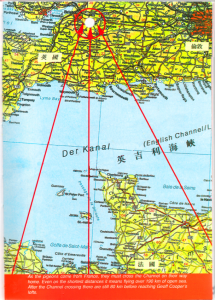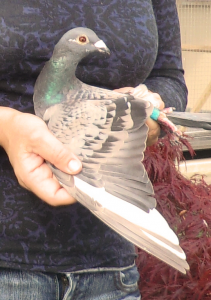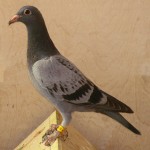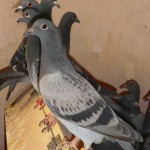We are asked many times about how to race young birds.
Below is a brief introduction to how we race our young birds.
When the first round is weaned and settled in their own section. The trap is always open for them to look out and have a look at their surroundings. When they first fly up onto the loft roof, it is always a worrying time as they are very vulnerable to the many hawks we have around here. It is important all the young birds are very healthy and have had a good start in life, we do not use any “preventative” treatments, they are vaccinated against PMV and Salmonella. They are fed all they want to eat of a good quality mixture. Once they are up on the perches we feed a mix more like a widowhood mixture, we do not want them to have too much protein as we find they do not get up and fly very quick if they have a diet heavy in protein. Before they are flying they have a hopper full of food in front of them all the time. When they start flying they are fed approximately 40gm per bird per day. We always add 5% barley to their food. This is a good guide to whether they are having enough food or not. If you have a little barley left you have fed enough. If they have eaten all the barley then you have not given them enough. Every time they feed, starting from when they are weaned, we blow a whistle when they feed, then when they are out and you want them to come in, we blow the whistle and they are straight in.
Before young bird racing starts they are out for about three hours in the middle of the day and I like them to be flying well for at least an hour before they have the first training toss. They have between 8 and 12 training tosses, starting at 3 miles through to 25 miles. We like to start training when they are about 12 weeks old but they must be regularly flying for at least an hour .
We aim to race between 80 and 100 young birds. It is important to breed as many young birds as you can house as this is the only sensible way you can test the worth of your stock birds.
We have two adjoining sections for young birds, we let them live together until they start to pair up, then they are split, cocks and hens are exercised separately. The cocks have every race inland, the ones out of proven breeders do not normally fly the Channel, the hens will have as many Channel races as they are fit to fly.

The red lines shown the flight path of our birds from the overseas races.
How young bird racing plays a part in developing a family.
In the mid 1990’s there were some Classic young birds races from Rennes in France. Our birds had to fly a distance of 225 miles, 350 + kms, of which 180 kms were over seas . We were one of the longer flyers, in the Northern section (province). These races were very hard for the young birds, even though they were at the end of the season when all the birds had experience of flying the English Channel, the returns were very poor, often with less than 5% making the result. After a few years these races were stopped because members got disheartened at not being able to get their birds home in race time.
This was a big disappointment for us, as our birds excelled in these hard sea races.
In 1994 we had a hard National race from St Malo France, when the birds were held over from the Saturday to the Monday. We had 11 of 12 entered home, the wind was west north west, which for us living in the west country is the worst possible wind as it is a head wind, giving the advantage to the members in the east. They were kept in on the Tuesday, exercised on the Wednesday and then basketed for another overseas race on Thursday, which were liberated on the Saturday. They were liberated in a strong west wind, with heavy showers on route. We were 1st, 2nd, 5th, 7th, and 10th club, and 3rd, 4th, 21st and 24th Combine 2552 birds with some of the young birds flying over 10 hours on the day. The birds we clocked were all bred down from our early 1980’s imports which are stil in our family today.
1995 was another hard season for young bird channel racing. We sent 12 to the young bird National from St Malo and clocked 10, with some flying nearly 11 hours, arriving home after 7pm when it is starting to get dark. The major young bird Classic’s and Nationals are always held in September, when the days were starting to get shorter due to the onset of winter. The last race of 1995 was the Classic from Rennes which were liberated at 9.30 am in a north, north east wind, a very hard head wind for young birds to fly into. This race was a disaster for many young birds, they did not have the strength or stamina to get home. We entered 10 and had nine home. We had the only five in the clock station on the day, the clock station is like the Belgium regions, smaller than the province but larger than a club. The last bird we timed on the day was clocked at 19.51.43, when it was dark, flying over ten hours on the wing. Not only did we have the only birds home on the day from this race, we had the first two home the next morning, making the first seven in the clock station and the first three in the section (province). The first bird we timed from this race was called “Jayne” who was bred from a brother of our Champion breeder “Titch”. “Titch” was a son of “53” bred from Geoff’s original imports. “Jayne” is the Grandmother of Paul Kendals Champion “Morning Glory” who was twice second National from Pau and Great Grandmother to Paul Kendals “Litton Lad” 1st National Tarbes 2010.
Our second pigeon a dark hen called “Bess” raced the Classic from Guernsey (overseas) where she was the third bird home, the next week “Bess” was sent to Truro an inland race in the opposite direction of 200 kms, where she was 1st club Truro 245b and 7th Combine Truro 5135b. The following week “Bess” was sent to the National from St Malo (overseas) where she was the 1st bird home. We sent twelve to this race and had ten home. Two weeks later we entered her into the Classic from Rennes where she was second section (province) beaten by “Jayne”
“Bess” was bred a grandaughter of “Bulldog” and a grandaughter of “53”. “Bulldog” and “53” were once again children of Geoff’s original imports, both bred in the “Golden Year” of 1984.
All the birds we timed in these races had the blood of our original imports in, I have mentioned just two”Jayne” and “Bess” as it was a long time ago, but it is important, to keep looking back over the records of these hard races and see what lines were performing well then, not just what birds, but the bloodlines of the birds. The birds we time now from the hard oversea young bird races all have the bloodlines of the birds mentioned above.
The last three years, our local club High Littleton www.hlfctours.co.uk has held a young bird National race from Tours in France. Most birds have to fly a distance over 400kms, our birds have to fly over 480 kms. The first race held in 2008 had an entry of 1090 birds. Not many you might think for a National, but this race is at the end of a season where most of the birds have flown overseas races and as the returns from these races are usually poor, the members have not got the birds left to send, but you can be sure the ones that are entered are the best of what the fanciers have left. Our first bird was 11th National and she was bred from a daughter of Farm Boy. In 2011 we timed a hen called “Wollongong”. Her Dam is a daughter of “Georgina” who is the Dam of “George”. Here is an excerpt from the High Littleton Tours race result :- “…..Geoff and Catherine Cooper of Peasedown St John. They timed a chequer white flight hen called Wollongong, named after a friend’s home town in Australia,who was watching the birds come home. She had flown the hard NFC St Malo race the week before and Carentan with the NFC two weeks before that, making this her third channel race in a row. She was raced on the sliding door system, and was paired to a young cock, she then changed her mind and paired to another hen, This other hen laid and both hens were sitting. The young cocks and hens were allowed to run together the day before basketing for St Malo NFC, the young cock which was paired to this hen pushed the other hen off the eggs and started sitting. He carried on sitting for four days until the hen came back from the St Malo NFC where she was approximately 10th section. The cocks and hens were then parted as usual except for this cock and hen, who carried on sitting the seconds hens eggs. She was sent sitting to Tours.
Geoff has created a family of birds that excel when the conditions are hard, he had five out of six home, by the time the race closed.
Her Dam is bred from Georgina, the mother of George 1st Grand National Tarbes when paired to Mttoto a top breeding cock bred by Bernard Deweerdt. Her Sire is a grandson of Brockamp’s Euro Diamond bred by Clive Lister.”
This family thrive on hard work, but we never race a pigeon, young or old unless it is 100% fit. We race the young birds seperated. They are exercised once a day, cocks and hens seperately. Prior to racing they will have between eight and twelve training tosses. If they are exercising well around the loft they do not need any more than this. We have a big hawk problem in this part of Great Britain and so less training means less hawk attacks. They are all raced every week, until the overseas races, then they are raced overseas every two weeks with an inland race, if possible in between. This is because of the extra day they have to spend in the basket. I never keep them short of food, in the early races I may lose a race because of a bad trap, but when they compete in the important overseas races, they are fitter and stronger than many of their competitors and my lofts results and returns are usually much better than other lofts. The hens which fly the best over this series of overseas races are kept for breeding from. This is the best way to improve and develope your family, race your young birds hard but fair, and breed from those which survive.

- “Wollongong” 4th National Tours 2010, the three years later 1st Int. Pau
I hope this article gives you an insight into how our young birds are bred, for racing the hard overseas races and hope you find it interesting how they can all be traced back to our original family.

first baby 2011

Farren, bred from Blue Legend.

first round weaned 2011




